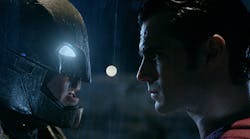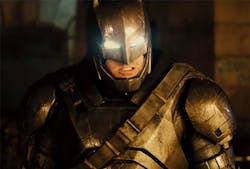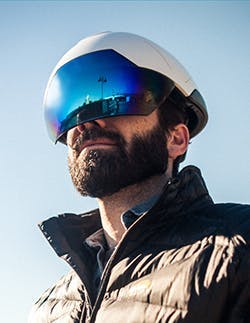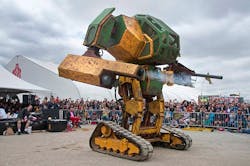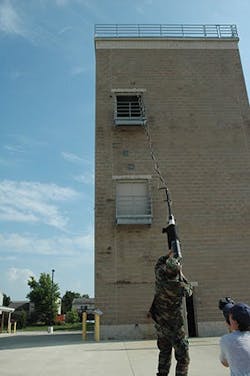If you think all the bat-weapons and bat-gadgets you’ll probably see in “Batman v Superman: Dawn of Justice” seem too bat-s*** crazy to exist in real life, you might not be up to super speed on the current state of advanced manufacturing.
Using existing technology, I believe it could be possible for Batman, an obsessed orphan billionaire with unlimited resources and the most strategic mind on the planet, to pose a legitimate threat to Superman.
I also once believed that getting bit by a spider I sequestered near a submarine nuclear reactor would make me Spider-Man (it died in the box and rubbing it on my skin didn’t work), so my opinion on science may be somewhat myopic when it comes to superheroes.
So I asked some of the greatest scientific minds on the planet for their opinion, and some of them, including scientists from NASA and Lockheed Martin, actually agreed to talk to me.
And surprisingly, they came up with ways technology and processes used every day in manufacturing could help Batman fight with Superman—and maybe even win.
Early Warning Detection
Batman may be a tactical genius, but timing is everything, and his opponent moves at supersonic speed.
The engineers at NASA Glenn Research Center in Cleveland, Ohio, have something that could buy Batman a few critical seconds: a high-speed smart camera that can detect supersonic shocks.
Developed for supersonic jets that must sense and adjust compressed air to prevent internal damage, the camera usually works in a closed-loop system to regulate the inlet and direct airflow.
“The denser area of air, the shock area, defracts light, and gets projected on the other side of the wall,” explains inventor Norm Prokop, a NASA mechanical engineer. Using an edge-detecting signaling processing circuit, which works at more than 900 frames per second, the camera monitors for little dark spots. He describes the linear array beam as working like the sensors that keep garage doors from closing on your foot.
The technology could also be used on high-speed assembly lines or for collision detection. Or to detect a red and blue blur making a beeline to kick your butt.
“It solves one of the basic computer vision problems, which is edge detection at a high speed, with a simple system,” Prokop says.
So would Bruce Wayne want to commercialize this as part of a Kryptonian early warning system spread out over Gotham? (Full disclosure: I did feel guilty for asking an actual NASA scientist this question.)
“I think it’s likely if you need to sense something quickly, for a reasonable price, and you reproduce in hundreds, a billionaire would use this to fight an alien,” Prokop says.
Internet of Bat Things
The bat computer connects to a car, jet, tracking sensors, and other people. That sounds exactly like how the Internet of Things works, and one software company isn't afraid to admit it.
"Batman has a whole bunch of systems he uses: the Bat cave with all his gear,and Alfred and Robin," says Ed English, Chief Product Officer for APX Labs says." Most of the things are connected into his Bat system. The way we implement our tech is thought of in a very similar way."
APX Labs calls it Skylight, and it connects wearables and enterprise systems to increase what workers can achieve in a day by augmenting their vision with live graphs and sensor data on a smart glasses, or allowing them to voice activate applications. Skylight will be able to work with the DAQRI Smart Helmet, so it should work with Batman's smart cowl.
"It gives the blue-collar worker superhuman powers," English says.
And it works for vigilantes, too!
"Anything that is networked, Batman can control with his voice. So if he's struggling with Superman, he can not only see what’s going on but activating things, like launching missiles."
And with Skylight's POV feature, the video could be streamed to allies for advice and instructions.
"It's not just Batman v Superman, it’s Batman and everyone he works with vs. Superman," English says.
Red-Eye Reduction
So about Superman’s heat vision. It’s a problem. But how big?
In the comics, Superman’s heat vision, a byproduct of his x-ray vision, can reach 1,950°C (3,542°F). The world’s most power x-ray laser, located at the LAC National Accelerator Laboratory, heated aluminum up to 2,000,000°C, so the comic book writer could be a couple degrees off.
In any event, for Bats to stand a chance, he needs to neutralize Superman’s long-range weapon with armor.
Connie Henshall, Research Science Senior Manager at the Lockheed Martin Advanced Technology Center, recommends Batman use a flexible suit made of nanomaterials, because they exhibit completely different behavior than bulk materials, such as melting point, conductivity, and heat.
Carbon nanotube fibers infiltrated with ceramic fibers have the best shot at enduring Superman’s deadly gaze, she says.
“That way it would be heat resistant like ceramic and have heat dissipation of carbon, an excellent thermal conductor.” Tungsten nanotubes could also be weaved in for laser reflection, she adds.
The weaving of nanomaterials was first reported in January of this year.
“First you have to grow carbon nanotubes on a flat surface. It would be like making fabric out of wool and twisting those fibers together as a coherent fabric.
It would be an arduous process, but with Batman’s resources, at least it’s possible.
Joy Buzzer
In “The Dark Knight Returns,” the graphic novel by Frank Miller that inspired much of the current movie’s climactic fight scene, Batman hooks into Gotham’s energy grid, via a lamp post, to shock Superman with his hands, in an ironic homage to the Joker.
Could plugging into a light post give the juice you need to take down an overpowered alien? It took 6,600V AC for the good folks at the Edison Company to electrocute an elephant, and that’s after dosing it with cyanide carrots. Superman would need at least that much to shock his system.
We asked Brent Purdy, product manager at AutomationDirect, to watch the above video and explain if this would work in real life.
“A light pole is usually 240v, 480v, something like that,” he explains. “and typically there a distribution transformer somewhere.”
That’s what steps down the grid power, which could be 5,000 to 48,000 vac, to a paltry 480 vac.
“I looked at it more like a Taser application,” the electrical engineer says. “Using a circuit with capacitor that charges up like a Taser, it would discharge and incapacitate.”
Purdy says it’s more likely Batman would need to tap into a higher voltage, such as the transformer box for a 10,000V security fence.
“He could tap into that charge up, a capacitor, and basically created a taser.”
Another way is possibly using an AC drive, like AutomationDirect’s DURAPULSE Series, which powers motors with high hp.
“It’s your light post in this video, Purdy says. “Open it up, disable the overcurrent protection, clip onto the DC bus and he’d be rockin’ and rolling.”
Best Suited
If he’s going up against a rotund, umbrella-toting mob boss or psychopathic clown prince, Batman’s many years of training, badass car, and a burning desire for vengeance can get him through even the longest night.
Against the godlike abilities of Superman, Batman needs more power. Wearing a mechanical suit with powered motors and servos for extra strength is nothing new for Batman; he does it all the time to fight metahumans, aliens, and most importantly, to sell action figures.
A mech suit sounds awesome, but D.J. Sures, founder and CEO of EZ-Robot, says this has too many engineering issues to behave like in the movie.
"There's a reason the world doesn’t have a number of exoskeleton suits like in science fiction," he says in an email.
He says it has a lot to do with thermodynamics:
Electrical motors provide static torque over the entire range of work (rpm). Now, if an electric motor can provide 100 ft/lbs of torque and the work is 200 ft/lbs, the energy needs to go somewhere. In this example, the motor cannot provide enough torque to perform the work, as in the case of Batman’s suit or Iron Man lifting a bridge. The electrical energy cannot move the motor so it generates heat. Energy cannot just “go away” or “disappear”, it needs to go somewhere. This is called Energy Transformation and the measurement is called Entropy. If the motor shaft cannot rotate due to the weight exceeding the maximum torque potential, the energy is transformed into heat. The motor will generate heat even if the shaft can rotate, but it will generate 100% of the energy potential to heat if the shaft cannot rotate.
So the biggest challenge with electrical motors is heat from exceeding the potential of torque. An internal combustion motor, in your car for example, will simply stall if the shaft cannot turn—it will not light on fire like an electric motor would.
Sures makes clear that once we embrace experimental technologies to improve batteries, motors, and sensors, an exoskeleton will be possible. After all, nanotube muscles that can lift 50,000 times their own weight and can work in 2,500°C do exist.
By the time the next Batman movie comes out, sometime after 2017, this could become a reality, because it has real applications.
"There are unlimited real-world use case scenarios for exoskeletons, so their development is not going to halt," Sures says. "The drive that keeps robotics and exoskeleton development going is to adventure humans into uncharted territory with safety. To have exoskeletons gives us the ability to explore space, oceans, and other dangerous environments. It also assists disabled individuals to do the same! As a serious technophile, I see a future where humans and machines merge, like 'Ghost in the Shell.'"
He's not far off, as Japanese and American companies have already begun merging man and machine for a battle for the ages. It won't lead to a dawn of justice, but hopefully, a giant robot fighting league.
Escape Plan
Unlike real bats, Batman can't fly, but with his trusty batclaw—a handheld grappling hook—the Dark Knight can quickly rise out of any bad situation, like if someone is throwing part of a building or a car at him.
A grappling gun that works just like Batman's seems to be pure fantasy,although the Navy SEALs have their own shoulder-mounted grappling cannon for ship boarding, invented by Jim LaBine of Battelle.
It has also appeared on "Mythbusters" and "The Man From U.N.C.L.E.", which current Superman Henry Cavill also starred in.
LaBine says it operates around 300 psi "so if the tank becomes damaged, it doesn’t blow up in their hands.It's shoulder-fired to reduce recoil and has a muffled noise for stealth.
Would a handheld version be possible?
"We did calculations for pressure-volume and barrel length," he says. "Adjusting those you can pretty much build or do anything based on the weight you are trying to shoot. If you went really small, your pressure would have to go up.
"So with a small compressed air cartridge, which can be 1-in long and 3,000 psi, could Batman fire a grapple from a gun?
"I think it is possible," LaBine says. "The key would be to get that pressure behind your projectile so it can act over that small distance."










